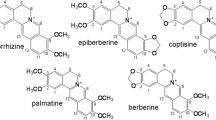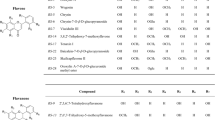Abstract
α-Glucosidase inhibitors in natural products are one of the promising drugs for the treatment of type 2 diabetes. However, due to the complexity of the matrix, it is challenging to comprehensibly clarify the specific pharmacodynamic substances. In this study, a novel high-throughput inhibitor screening strategy was established based on covalent binding of α-glucosidase on chitosan-functionalized multi-walled carbon nanotubes coupled with high-resolution mass spectrometry. The synthesized MWCNTs@CS@GA@α-Glu was characterized by TEM, SEM, FTIR, Raman, and TG. Performance studies showed that the microreactor exhibited stronger thermostability and pH tolerance than that of the free one while maintaining its inherent catalytic activity. Feasibility study applying a model mixture of known α-glucosidase ligand and non-ligands indicated the selectivity and specificity of the system. By integrating ultra-high-performance liquid chromatography-tandem mass spectrometry (UHPLC-QTOF-MS) with ion mobility mass spectrometry (IMS), 15 ligands were obtained and tentatively identified from Tribulus terrestris L., including 8 steroidal saponins, 4 flavonoids, and 3 alkaloids. These inhibitors were further validated by in vivo experiments and molecular docking simulation.








Similar content being viewed by others
References
Sun W, Wu C, Fan G, Hao G, Shi H, Zhang C. Preparation of a functional beverage with alpha-glucosidase inhibitory peptides obtained from ginkgo seeds. J Food Sci Technol-Mysore. 2021;58(12):4495–503. https://doi.org/10.1007/s13197-020-04931-3.
Ercan P, El SN. Inhibitory effects of chickpea and Tribulus terrestris on lipase, α-amylase and α-glucosidase. Food Chem. 2016;208:338. https://doi.org/10.1016/j.foodchem.2016.04.062.
Hunziker W, Spiess M, Semenza G, Lodish HF. The sucrase-isomaltase complex: primary structure, membrane-orientation, and evolution of a stalked, intrinsic brush border protein. Cell. 1986;46(2):227–34. https://doi.org/10.1016/0092-8674(86)90739-7.
Li P, Ma XH, Dong YM, Jin L, Chen J. alpha-Glucosidase immobilization on polydopamine-coated cellulose filter paper and enzyme inhibitor screening. Anal Biochem. 2020;605:113832. https://doi.org/10.1016/j.ab.2020.113832.
Iijima S. Helical microtubules of graphitic carbon. Nature. 1991;354(6348):56–8. https://doi.org/10.1038/354056a0.
Yang S, Zhao D, Xu Z, Yu H, Zhou J. Molecular understanding of acetylcholinesterase adsorption on functionalized carbon nanotubes for enzymatic biosensors. Phys Chem Chem Phys. 2022;24(5):2866–78. https://doi.org/10.1039/d1cp04997f.
Jin X-H, Ishii A, Aoki K, Ishida S, Mukasa K, Ohno S. Detection of human adenovirus hexon antigen using carbon nanotube sensors. J Virol Methods. 2011;171(2):405–7. https://doi.org/10.1016/j.jviromet.2010.12.004.
Fan PC, Liu LJ, Guo QH, Wang JL, Yang JH, Guan XY, et al. Three-dimensional N-doped carbon nanotube@carbon foam hybrid: an effective carrier of enzymes for glucose biosensors. Rsc Adv. 2017;7(43):26574–82. https://doi.org/10.1039/c7ra02592k.
Kim Y, Hong JS, Moon SY, Hong J-Y, Lee JU. Evaluation of carbon nanotubes dispersion in aqueous solution with various dispersing agents. Carbon Lett. 2021;31(6):1327–37. https://doi.org/10.1007/s42823-021-00285-8.
Koppolu Bp, Smith SG, Ravindranathan S, Jayanthi S, Suresh Kumar TK, Zaharoff DA. Controlling chitosan-based encapsulation for protein and vaccine delivery. Biomaterials. 2014;35(14):4382–9. https://doi.org/10.1016/j.biomaterials.2014.01.078.
Liu X, Dong X, Zhong S, Xia J, He J, Deng Y, et al. One-step solid-state fermentation for efficient erythritol production from the simultaneous saccharified crop wastes by incorporating immobilized cellulase. Ind Crop Prod. 2022;176:114351. https://doi.org/10.1016/j.indcrop.2021.114351.
Yu Y, Zhang Z, Dai L, Wang F. Copolymer-induced intermolecular charge transfer: enhancing the activity of metal-free catalysts for oxygen reduction. Chem-Eur. 2019;25(22):5652–7. https://doi.org/10.1002/chem.201806226.
Welsher K, Liu Z, Daranciang D, Dai H. Selective probing and imaging of cells with single walled carbon nanotubes as near-infrared fluorescent molecules. Nano Lett. 2008;8(2):586–90. https://doi.org/10.1021/nl072949q.
Zhan Y, Pan L, Nie C, Li H, Sun Z. Carbon nanotube–chitosan composite electrodes for electrochemical removal of Cu(II) ions. J Alloy Compd. 2011;509(18):5667–71. https://doi.org/10.1016/j.jallcom.2011.02.118.
Razzokov J, Marimuthu P, Saidov K, Ruzimuradov O, Mamatkulov S. Penetration of chitosan into the single walled armchair carbon nanotubes: atomic scale insight. Crystals. 2021;11(10):1174.
Hwang J-Y, Kim H-S, Kim JH, Shin US, Lee S-H. Carbon nanotube nanocomposites with highly enhanced strength and conductivity for flexible electric circuits. Langmuir. 2015;31(28):7844–51. https://doi.org/10.1021/acs.langmuir.5b00845.
Rungrotmongkol T, Arsawang U, Iamsamai C, Vongachariya A, Dubas ST, Ruktanonchai U, et al. Increased dispersion and solubility of carbon nanotubes noncovalently modified by the polysaccharide biopolymer, chitosan: MD simulations. Chem Phys Lett. 2011;507(1):134–7. https://doi.org/10.1016/j.cplett.2011.03.066.
Shieh Y-T, Wu H-M, Twu Y-K, Chung Y-C. An investigation on dispersion of carbon nanotubes in chitosan aqueous solutions. Colloid Polym. 2010;288(4):377–85. https://doi.org/10.1007/s00396-009-2126-9.
Cheng G, Xing J, Pi Z, Liu S, Liu Z, Song F. α-Glucosidase immobilization on functionalized Fe3O4 magnetic nanoparticles for screening of enzyme inhibitors. Chin Chem Lett. 2019;30(3):656–9. https://doi.org/10.1016/j.cclet.2018.12.003.
Sorouraddin M-H, Amini K, Naseri A, Vallipour J, Hanaee J, Rashidi M-R. A new multi-wavelength model-based method for determination of enzyme kinetic parameters. J Biosci. 2010;35(3):395–403. https://doi.org/10.1007/s12038-010-0045-z.
Liu DM, Chen J, Shi YP. Screening of enzyme inhibitors from traditional Chinese medicine by magnetic immobilized alpha-glucosidase coupled with capillary electrophoresis. Talanta. 2017;164:548–55. https://doi.org/10.1016/j.talanta.2016.12.028.
Dadfar SMM, Kavoosi G, Dadfar SMA. Investigation of mechanical properties, antibacterial features, and water vapor permeability of polyvinyl alcohol thin films reinforced by glutaraldehyde and multiwalled carbon nanotube. Polym Compos. 2014;35(9):1736–43. https://doi.org/10.1002/pc.22827.
Bosley JA, Peilow AD. Immobilization of lipases on porous polypropylene: reduction in esterification efficiency at low loading. J Am Oil Chem Soc. 1997;74(2):107–11. https://doi.org/10.1007/s11746-997-0153-6.
Cheng G, Pi Z, Zheng Z, Liu S, Liu Z, Song F. Magnetic nanoparticles-based lactate dehydrogenase microreactor as a drug discovery tool for rapid screening inhibitors from natural products. Talanta. 2020;209:120554. https://doi.org/10.1016/j.talanta.2019.120554.
Wu X, Qiu B, Chen Y, Shi Y, Zhu J, Liu X, et al. Online coupling Fe3O4@ZIF-67@alpha-glucosidase biomicroreactor with high performance liquid chromatography for rapid screening of alpha-glucosidase inhibitors in tea and their inhibitory activity research. J Chromatogr B. 2020;1159:122398. https://doi.org/10.1016/j.jchromb.2020.122398.
Ma F, Wang Y, Yang G. The Modulation of Chitosan-DNA Interaction by Concentration and pH in Solution. Polymers. 2019;11(4). https://doi.org/10.3390/polym11040646.
Liu DM, Chen J, Shi YP. alpha-Glucosidase immobilization on chitosan-enriched magnetic composites for enzyme inhibitors screening. Int J Biol Macromol. 2017;105(Pt 1):308–16. https://doi.org/10.1016/j.ijbiomac.2017.07.045.
Aggarwal S, Ikram S. Zinc oxide nanoparticles-impregnated chitosan surfaces for covalent immobilization of trypsin: stability & kinetic studies. Int J Biol Macromol. 2022;207:205–21. https://doi.org/10.1016/j.ijbiomac.2022.03.014.
Singh AN, Singh S, Suthar N, Dubey VK. Glutaraldehyde-activated chitosan matrix for immobilization of a novel cysteine protease. Procerain B Food Chem. 2011;59(11):6256–62. https://doi.org/10.1021/jf200472x.
Diyanat S, Homaei A, Mosaddegh E. Immobilization of Penaeus vannamei protease on ZnO nanoparticles for long-term use. Int J Biol Macromol. 2018;118:92–8. https://doi.org/10.1016/j.ijbiomac.2018.06.075.
He J, Sun S, Zhou Z, Yuan Q, Liu Y, Liang H. Thermostable enzyme-immobilized magnetic responsive Ni-based metal-organic framework nanorods as recyclable biocatalysts for efficient biosynthesis of S-adenosylmethionine. Dalton Trans. 2019;48(6):2077–85. https://doi.org/10.1039/c8dt04857f.
Tavares APM, Silva CG, Dražić G, Silva AMT, Loureiro JM, Faria JL. Laccase immobilization over multi-walled carbon nanotubes: kinetic, thermodynamic and stability studies. J Colloid Interface Sci. 2015;454:52–60. https://doi.org/10.1016/j.jcis.2015.04.054.
Javid A, Amiri H, Kafrani AT, Rismani-Yazdi H. Post-hydrolysis of cellulose oligomers by cellulase immobilized on chitosan-grafted magnetic nanoparticles: a key stage of butanol production from waste textile. Int J Biol Macromol. 2022. https://doi.org/10.1016/j.ijbiomac.2022.03.013.
Khan M, Husain Q, Bushra R. Immobilization of β-galactosidase on surface modified cobalt/multiwalled carbon nanotube nanocomposite improves enzyme stability and resistance to inhibitor. Int J Biol Macromol. 2017;105(Pt 1):693–701. https://doi.org/10.1016/j.ijbiomac.2017.07.088.
Amin F, Bhatti HN, Bilal M, Asgher M. Improvement of activity, thermo-stability and fruit juice clarification characteristics of fungal exo-polygalacturonase. Int J Biol Macromol. 2017;95:974–84. https://doi.org/10.1016/j.ijbiomac.2016.10.086.
Li P, Ma XH, Jin L, Chen J. Dopamine-polyethyleneimine co-deposition cellulose filter paper for alpha-Glucosidase immobilization and enzyme inhibitor screening. J Chromatogr B. 2021;1167:122582. https://doi.org/10.1016/j.jchromb.2021.122582.
Wan GZ, Ma XH, Jin L, Chen J. alpha-glucosidase immobilization on magnetic core-shell metal-organic frameworks for inhibitor screening from traditional Chinese medicines. Colloid Surf B-Biointerfaces. 2021;205:111847. https://doi.org/10.1016/j.colsurfb.2021.111847.
Wan GZ, Ma XH, Jin L, Chen J. alpha-glucosidase immobilization on magnetic core-shell metal-organic frameworks for inhibitor screening from traditional Chinese medicines. Colloids Surf B Biointerfaces. 2021;205:111847. https://doi.org/10.1016/j.colsurfb.2021.111847.
Wubshet SG, Liu B, Kongstad KT, Böcker U, Petersen MJ, Li T, et al. Combined magnetic ligand fishing and high-resolution inhibition profiling for identification of α-glucosidase inhibitory ligands: a new screening approach based on complementary inhibition and affinity profiles. Talanta. 2019;200:279–87. https://doi.org/10.1016/j.talanta.2019.03.047.
Jiang J, Yu Y, Wang L, Li J, Ling J, Li Y, et al. Enzyme immobilized on polyamidoamine-coated magnetic microspheres for α-glucosidase inhibitors screening from Radix Paeoniae Rubra extracts accompanied with molecular modeling. Talanta. 2019;195:127–36. https://doi.org/10.1016/j.talanta.2018.11.009.
Meng X, Xing JP, Liu S, Liu ZQ, Song FR. Comprehensive chemical profiling and potential chemical marker’s evaluation of Tribulus terrestris by UPLC-QTOF-MS in combination with ion mobility spectrometry. J Pharm Biomed Anal. 2022;217. https://doi.org/10.1016/j.jpba.2022.114839.
Zhang Q, Xiao X, Li M, Li W, Yu M, Zhang H, et al. Acarbose reduces blood glucose by activating miR-10a-5p and miR-664 in diabetic rats. PLoS ONE. 2013;8(11):e79697. https://doi.org/10.1371/journal.pone.0079697.
Nepal MR, Kang MJ, Kim GH, Cha DH, Kim JH, Jeong TC. Role of intestinal microbiota in metabolism of voglibose in vitro and in vivo. Diabetes Metab J. 2020;44(6):908–18. https://doi.org/10.4093/dmj.2019.0147.
Song X, Yuan Y, Wang S, Sun X, Zhang C, Gao P, et al. Pharmacokinetic comparisons of six steroid saponins in rat plasma following oral administration of crude and stir-fried Fructus Tribuli extracts by UHPLC-MS/MS. Biomed Chromatogr. 2021;35(10):e5151. https://doi.org/10.1002/bmc.5151.
Han L, Song J, Yan C, Wang C, Wang L, Li W, et al. Inhibitory activity and mechanism of calycosin and calycosin-7-O-β-D-glucoside on α-glucosidase: Spectroscopic and molecular docking analyses. Process Biochem. 2022;118:227–35. https://doi.org/10.1016/j.procbio.2022.04.035.
Funding
This work was supported by the National Nature Science Foundation of China (No. 81273952) and the Science and the Youth Innovation Promotion Association of CAS (Grant No. 2019227).
Author information
Authors and Affiliations
Corresponding author
Ethics declarations
Animal studies
Animal experiments were approved by the Animal Ethics Committee of Changchun Institute of Applied Chemistry (approval number: 2021-39), and were performed in compliance with the NIH guide for the care and use of laboratory animals.
Conflict of interest
The authors declare no competing interests.
Additional information
Publisher's note
Springer Nature remains neutral with regard to jurisdictional claims in published maps and institutional affiliations.
Supplementary Information
Below is the link to the electronic supplementary material.
Rights and permissions
Springer Nature or its licensor (e.g. a society or other partner) holds exclusive rights to this article under a publishing agreement with the author(s) or other rightsholder(s); author self-archiving of the accepted manuscript version of this article is solely governed by the terms of such publishing agreement and applicable law.
About this article
Cite this article
Meng, X., Zong, H., Zheng, Z. et al. Ligand-targeted fishing of α-glucosidase inhibitors from Tribulus terrestris L. based on chitosan-functionalized multi-walled carbon nanotubes with immobilized α-glucosidase. Anal Bioanal Chem 415, 2677–2692 (2023). https://doi.org/10.1007/s00216-023-04666-y
Received:
Revised:
Accepted:
Published:
Issue Date:
DOI: https://doi.org/10.1007/s00216-023-04666-y




